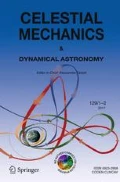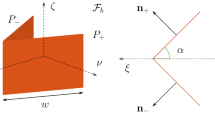Abstract
This paper presents an analysis of solar radiation pressure induced coupled librations of gravity stabilized cylindrical spacecraft with a special reference to geostationary communication satellites. The Lagrangian approach is used to obtain the corresponding equations of motion. The solar induced torques are assumed to be free of librational angles and are represented by their Fourier expansion. The response and periodic solutions are obtained through linear and nonlinear analyses, using the method of harmonic balance in the latter case. The stability conditions are obtained using Routh-Hurwitz criteria. To establish the ranges of validity the analytic response is compared with the numerical solution. Finally, values of the system parameters are suggested to make the satellite behave as desired. Among these is a possible approach to subdue the solar induced roll resonance. It is felt that the approximate analysis presented here should significantly reduce the computational efforts involved in the design and stability analysis of the systems.
Similar content being viewed by others
Abbreviations
- A m, n :
-
Integration constants, Equations (10)
- C E :
-
(1+Cλ)+(1−Cλ)C2ν
- Cq, Sq :
-
cosq, sinq
- F 1,xk :
-
∂F 1/∂x k , Equations (23)
- I x ,I y ,I z :
-
Principal moments of inertial,I y =I z >I
- K :
-
Inertia parameter,(I y −I x )/I z
- m i ,m j ,m k :
-
Torque along the principal axes
- Q i (i=1, 2, 3):
-
Generalized force corresponding toθ 1,θ 2,θ 3, respectively
- b, l :
-
Satellite radius and semilength
- c :
-
4p 0 blε p r 3 p (1−τ +ρ)/4l(1−τ +ρ/3)
- e :
-
Eccentricity of the orbit
- g :
-
πb(1−τ-ρ)/4l(1−τ+ρ/3)
- i :
-
Orbital inclination with respect to equatorial plane, Figure 1a
- \(\bar i, \bar j, \bar k\) :
-
Unit vectors alongx, y, z, respectively
- p 0 :
-
Solar induced pressure, 0.4755×10−6 kg m−2
- r, r p :
-
Orbital radius, perigee radius, respectively
- ū :
-
Earth to Sun unit vector
- x 0,x 2,x 4 :
-
Amplitudes in Equation (15b)
- x 1,x 3,x 5 :
-
Amplitudes in Equation (15a)
- x, y, z :
-
Principal axes withx nominally along the local vertical (yaw axis),y along the motion (roll axis), andz normal to the orbit (pitch axis)
- θ 1,θ 2,θ 3 :
-
Pitch, yaw and roll angles, respectively
- δ:
-
Variation in roll periodic solution, Equation (21)
- ε p :
-
Distance between center of mass and pressure, positive when the latter is beneath the former
- η, ξ:
-
Infinitesimal variations, Equation (18)
- θ:
-
True anomaly of the satellite from perigee, Figure 1a
- \(\bar \theta \) :
-
θ−ν, where ν is solar aspect angle
- λ:
-
Angle between ecliptic and equatorial plane
- \(\bar \lambda \) :
-
λ−i, orbital inclination with respect to ecliptic plane
- μ:
-
Gravitational constant, 0.398603×106 km3 s−2
- ρ, τ:
-
Reflectivity and transmissivity of the surface of the satellite
- 0:
-
Initial condition\(\bar \theta = 0\)
- ′:
-
d/dθ
References
Beletskii, V. V.: 1966, NASA TTF, No. 429.
Hayashi, C.: 1964, McGraw-Hill, New York.
Modi, V. J. and Brereton, R. C.: 1969a,AIAA 7, 1217.
Modi, V. J. and Brereton, R. C.: 1969b,AIAA,7, 1465.
Modi, V. J. and Flanagan, R. C.: 1971,Aeronaut. J. 75, 783.
Modi, V. J. and Kumar, K.: 1971, in L. G. Napolitano (ed.),Proceedings of the XXII Congress of the International Astronautical Federation, North-Holland Publ. Co., Amsterdam, Holland.
Modi, V. J. and Kumar, K.: 1974,AIAA J. 10, 225.
Modi, V. J. and Neilson, J. E.: 1972,Celes. Mech. 5, 126.
Modi, V. J. and Pande, K. C.: 1975,Celes. Mech. 11, 195.
Modi, V. J. and Shrivastava, S. K.: 1972,C.A.S.I. Transactions 5, 5.
Author information
Authors and Affiliations
Rights and permissions
About this article
Cite this article
Shrivastava, S.K., Hablani, H.B. Analysis of solar radiation pressure induced coupled liberations of a gravity stabilized axisymmetric satellite. Celestial Mechanics 20, 297–313 (1979). https://doi.org/10.1007/BF01371368
Received:
Accepted:
Issue Date:
DOI: https://doi.org/10.1007/BF01371368




